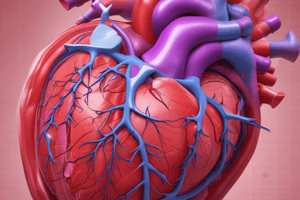Podcast
Questions and Answers
Where is the organ located in relation to the thoracic vertebrae?
Where is the organ located in relation to the thoracic vertebrae?
- Between the 1st and 4th thoracic vertebrae
- Anterior to the 5th to 8th thoracic vertebrae (correct)
- Posterior to the 7th thoracic vertebra
- Inferior to the 9th thoracic vertebra
What is the approximate weight range of the organ?
What is the approximate weight range of the organ?
- 150-200 grams
- 400-450 grams
- 300-350 grams
- 250-300 grams (correct)
What proportion of the organ lies to the left of the median plane?
What proportion of the organ lies to the left of the median plane?
- One quarter
- Two thirds (correct)
- Half
- One third
What is the general size of the organ compared to a common object?
What is the general size of the organ compared to a common object?
How is the distribution of the organ in relation to the median plane?
How is the distribution of the organ in relation to the median plane?
What type of geometric shape is described in the content?
What type of geometric shape is described in the content?
In which region of the thoracic vertebrae does this structure lie?
In which region of the thoracic vertebrae does this structure lie?
What anatomical structures separate this quadrilateral from the middle thoracic vertebrae?
What anatomical structures separate this quadrilateral from the middle thoracic vertebrae?
Which of the following best describes the orientation of the quadrilateral?
Which of the following best describes the orientation of the quadrilateral?
What bounds the structure described inferiorly?
What bounds the structure described inferiorly?
Which lymph nodes do the lymphatics draining the lateral parts of the pericardium primarily pass to?
Which lymph nodes do the lymphatics draining the lateral parts of the pericardium primarily pass to?
Which of the following is NOT a lymph node that the lymphatics from the pericardium drain into?
Which of the following is NOT a lymph node that the lymphatics from the pericardium drain into?
Which lymphatic node is specifically associated with the drainage of the pericardium near the esophagus?
Which lymphatic node is specifically associated with the drainage of the pericardium near the esophagus?
What is the additional lymphatic drainage site for the pericardium other than anterior mediastinal lymph nodes?
What is the additional lymphatic drainage site for the pericardium other than anterior mediastinal lymph nodes?
What type of lymphatic node is NOT mentioned in the drainage system of the pericardium?
What type of lymphatic node is NOT mentioned in the drainage system of the pericardium?
What forms the right 2/3 of the ventricular part?
What forms the right 2/3 of the ventricular part?
Which structure separates the right and left ventricles?
Which structure separates the right and left ventricles?
What does the anterior interventricular groove lodge?
What does the anterior interventricular groove lodge?
Which ventricle forms the left 1/3 of the ventricular part?
Which ventricle forms the left 1/3 of the ventricular part?
What is the relationship between the anterior interventricular artery and the left coronary artery?
What is the relationship between the anterior interventricular artery and the left coronary artery?
Where is the superior right point of the heart located?
Where is the superior right point of the heart located?
What is the distance of the superior left point from the midline?
What is the distance of the superior left point from the midline?
Which location corresponds to the superior left point of the heart?
Which location corresponds to the superior left point of the heart?
What is the midline reference in the context of heart surface anatomy?
What is the midline reference in the context of heart surface anatomy?
How far is the superior right point from the midline?
How far is the superior right point from the midline?
Flashcards are hidden until you start studying
Study Notes
Lymphatic Drainage of the Pericardium
- Lymphatics draining the lateral parts of the pericardium pass to the anterior mediastinal, tracheobronchial, lateropericardial, prepericardial, and posterior mediastinal (juxtaesophageal) lymph nodes.
Heart - Location and Size
- The heart is located anterior to the 5th to 8th thoracic vertebrae.
- It is approximately the size of a fist and weighs 250-300 grams.
Heart - Anatomical Position and Orientation
- It is quadrilateral and directed posteriorly.
- Lies opposite the middle thoracic vertebrae (5-7), separated from them by the descending aorta, esophagus, and oblique sinus of the pericardium.
Heart - Inferior Boundary
- Bounded inferiorly by the posterior ventricular part.
Heart - Ventricles
- The right two-thirds of the heart is formed by the right ventricle.
- The left one-third of the heart is formed by the left ventricle.
- The ventricles are separated by the anterior interventricular groove, which lodges the Anterior interventricular artery (branch of the left coronary) and the Great cardiac vein.
Surface Anatomy of the Heart: Superior Landmarks
- Superior right point: Upper border of the 3rd right costal cartilage, one inch from the midline.
- Superior left point: Lower border of the 2nd left costal cartilage, 3cm to the left of midline.
Studying That Suits You
Use AI to generate personalized quizzes and flashcards to suit your learning preferences.




